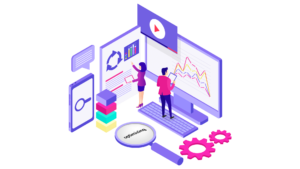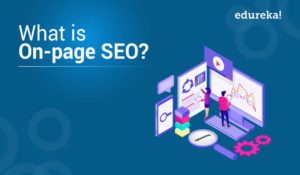The way you optimize your content plays has a major impact on its ability to rank. This suggests that On-Page SEO is very important and is also one of the notable SEO techniques to generate possible leads and sales. So this article will be your guide to help you with what is On-Page SEO.
These are the topics to be covered in this article:
- What is On-Page SEO?
- Importance of On-Page SEO
- What are the On-Page ranking factors?
- Proper insights about On-Page SEO
- Best Tricks & Practices
What is On-Page SEO?
On-Page SEO is basically a practice of optimizing individual webpages to rank higher on the Search Engine Result Pages (SERPs). This signifies that you will be optimizing both content and corresponding HTML source code. And, the best part about this is, it generates effective traffic onto your website.
Talking about the stats,
- In 2019, Google accounted for close to 75% of all search traffic.
- 67% of all clicks to go the top 5 organic search results.
- 93% of Google traffic is based on HTTP sites.
- 36% of professionalists think title tags are more important.
- 42% of SEO practices are carried out by internal and external links.
Importance of On-Page SEO
Internet marketing has grown to its peaks in recent days. And most of them have shifted their focus from Social Media, Email to SEO practices. Having an SEO team in your organization has become a necessity rather than a requirement.
Some people think SEO is dead but, the reality is completely different. SEO is more active and also is helping out a lot lately. Until you optimize your content on-site, you cannot push it to appear on the Search Engine Result Pages (SERPs). The more your website ranks higher, the more is the traffic and also the sales.
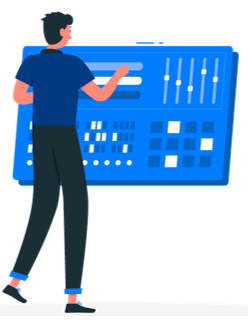
With an estimate of 46 billion reaches across the globe, Digital Marketing is sliding towards programmatic advertising and more than 85% of ads would be automated. This means, time management is sorted and also less workforce. So, in order to make your website look appealing and wonderful, On-Page SEO is used.
What are the On-Page ranking factors?
No matter how good your content is, it wouldn’t rank higher if you don’t include the SEO techniques. Ranking your webpage higher on the SERPs is a task in hand. So, let’s dive in further into this article to understand the factors that influence the On-Page ranking.
1. Title Tags
Title tags contribute a lot to your ranking on the SERPs. A Title Tag is an HTML element that specifies the title of your website. It is always the text displayed on the SERPs which is a clickable header.
Code sample
<head> <title>What is On-Page SEO? </title> </head>
What’s the point in having a Title tag? Why is it used?
Why Title Tags?
Title tags are the first impression of your organization. It is the way a viewer looks at your website. Majorly title tags are used in:
- SERP: The audience can view your content on the Search Engines
- Web Browsers: Saves your content from getting more results related to the keyword
- Social media network: Recognition in the social network

The above image shows how the title tag is visible to the viewers. You can add your corresponding keyword in the title and include the same in your page content. Always make sure,
- You have the title tags lengths checked
- Don’t over add the keywords in the SEO title
- Always have a unique title
- Add important keywords at the beginning of the title
- Branding your business. Add your company name at the end of the title
2. Heading/Headers
Headers are used to drive more attention to the topic you will be discussing. These are basically used to highlight a particular topic.

3. Page Content
Creating a very impressive content and adding out of the box ideas to improvise your webpage is definitely going to help the audience know about your business and the quality of content you create.
Linking another article or a webpage is going to benefit you as well as the external post. Even Backlinks drives quite a lot of traffic on your website. Internal and external links also help rank your website higher.
So, it is necessary to create content that has your keyword included and try to include them where ever you can. But, do not overdo it and stuff your keyword.
Add relevant images and try to include the keyword in the Alt text.
Sample Template
- A minimum of 300-1200 words in the article.
- Try to use more images in the content. A minimum of 3-10 images can be added.
- Highlighting the subheadings. Try to make it more grasping and crisp.
- Linking is a must. Add corresponding internal and external links to the content.
- Sort out your content and try to make a table out of it as it drives more attention of the viewer.
Proper insights about On-Page SEO
Research
Before building your content, try to analyze and build a storyline of what you want to convey. Then categorize them in a genuine manner and elaborate them.
- Look at how other websites that are ranking on SERP have pitched in their content and implement it in a better way.
- Add relevant images. Know what images to add and where.
- Proper usage of keywords is also important. Don’t try to stuff more keywords until you want to use shortcuts like Black Hat SEO for making your webpage rank.
- Research a lot about stats that justify whatever you are working on.
Keyword Analysis
Keywords are the building blocks of your content. The more you focus on your keyword, the more content you can add and more involving the website would be.
- Search on Google for Search Synonyms: Concentrate including your keyword and it’s synonyms in the content.
- Add suggested keywords: The more you can get all keywords under a single roof, the more you can rank on those keywords.
So, on the whole, having On-Page SEO can help you promote your product as well as be socially active on platforms like Facebook, Instagram, Twitter, LinkedIn and so on.
Moving on, let’s talk about the best tricks in On-Page SEO.
Best Tricks & Practices
On-Page SEO is a bit tricky and requires a lot of attention. So, having some idea about a few easy ways will definitely be your savior.
Breadcrumbs
Breadcrumbs are the links that help you in tracking the path from the page that the user is currently viewing. These are the ones that appear near the top of the page and reflect the structure of your website.
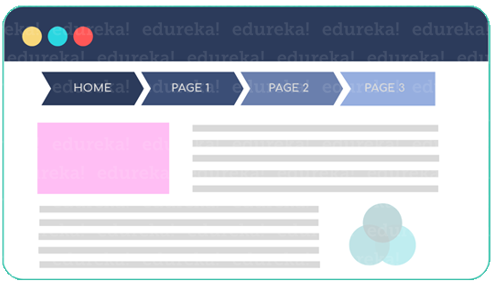
But, why is this required and how do these affect SEO?
Let’s understand how.
Usability
Breadcrumbs help users not only trace their paths but also help them giving similar pages. These help in minimizing the negative factors that decrease the bounce rate of your website.
- It helps the users to understand the layout.
- Enables users to scan through your website.
- Breadcrumbs provide a better understanding of the content.
How to use Breadcrumbs to improve On-Page SEO?
- Make use of Breadcrumbs only when they are necessary.
- Place them at the top of the webpage.
- Always start from the Home page, and proceed further with the consecutive pages.
- Try not to link to the current page.
- Stylize them to make them appealing, but not the center of attraction.
- Your breadcrumbs are your secondary navigation. They should never replace the primary navigation.
- Include a full navigation path in your breadcrumbs. Skipping a level can confuse users.
- Do not use the breadcrumb in the title.
Meta Description
A meta description is an HTML tag.

This holds an overview of what you want to convey to your customers or prospects.

Meta description of any article you write looks like this. Optimizing this with the target keyword is a task and also should be of a length ranging up to 155 characters.
Images and Alt text
As far as your content matters, corresponding images also tend to drive more traffic to your website. More specifically, add keywords in the alt tag. This will help your images rank on the Search engines.
- An alt tag is very essential in the name of the image.
- All images should use appropriate alt tags for the images.
- Not only are alt tags good for search engines, but they are also good for accessibility.
- Use – (dash) between the words. Try to reduce the usage of an underscore.
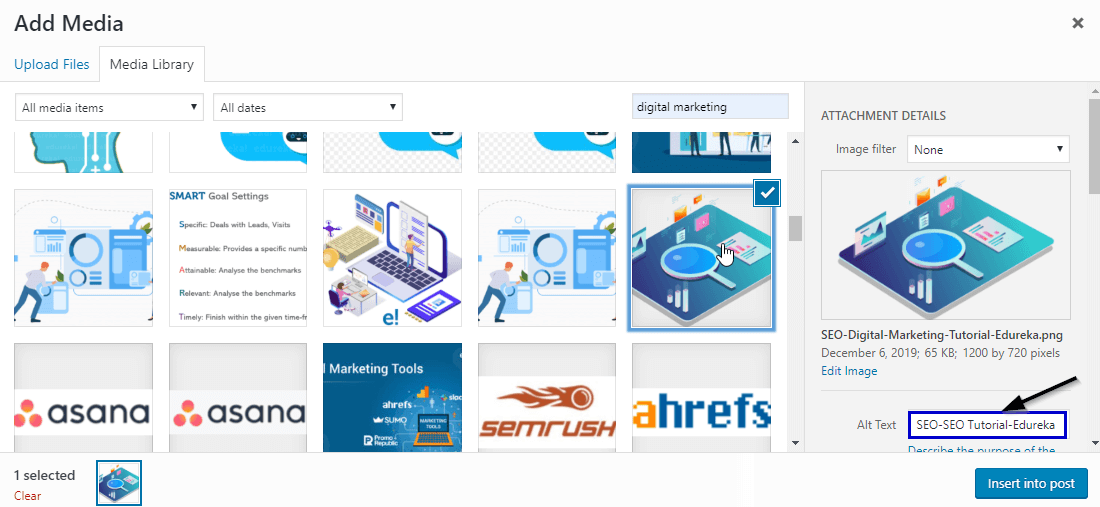
Best Practices
- Add your focus keyword in the beginning.
- Always have a unique title and description.
- Try to include your keyword in the URL.
- Optimize your sheet loading speed.
- Have corresponding inbound and outbound links.
- Post long content.
- Add images with Alt-Tag.
With this, we come to the end of this article on What is On-Page SEO. I hope you guys are clear about the topics that are covered in this blog. If you have any doubts regarding this topic, feel free to mention them in the comment section below.
If you wish to enroll for a complete Digital Marketing certification course, Edureka has a specially curated Digital Marketing Post-Graduate Program which will help you gain expertise in various digital media aspects like Keyword Planning, SEO, Social Media Marketing, Search Engine Marketing, Email Marketing, Affiliate Marketing, and Google Analytics.






